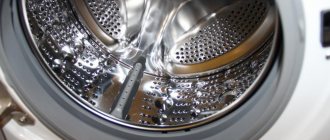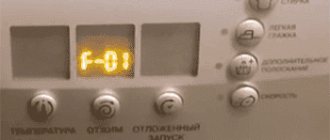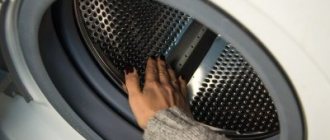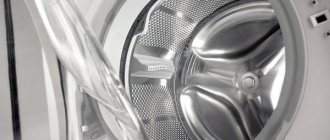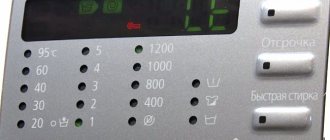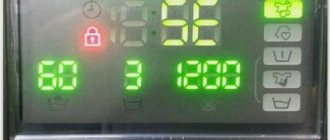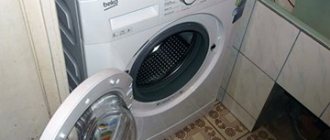So, another big wash has arrived. Pre-sorted items are thrown into the washing machine, the required amount of powder is poured, conditioner or bleach is added, and a water softener is added if necessary. Select the appropriate program, press the “Start” button and…. after a while we discover that the drum in the washing machine does not spin. In this situation, the main thing is not to panic, but to determine at what exact moment the drum stopped rotating. This information will significantly help when diagnosing a breakdown:
- During the spin cycle, the items are damp or wet, but not soapy; the rinsing and draining function has worked. There is a high probability that the belt came off at maximum speed.
- When washing, things and the entire internal volume are covered in foam. Moreover, if the drum cannot be moved from its place by hand, then the reason is purely mechanical; most often, the movement is jammed by a foreign object. If the drum can be easily turned by hand, then the cause of the breakdown is in the electric motor or electronics.
There are several other reasons why the washing machine does not spin the drum:
- A foreign object has entered the space between the drum and the inner wall of the tank.
- The failed bearing is jammed.
- The belt drive from the electric motor has fallen off or broken.
- The brushes in the electric motor have worn out due to frequent use.
- The engine completely failed.
- Control module failure.
The main reasons why the drum of a washing machine does not spin can be domestic, mechanical or technical.
Household items include:
- Overload Many modern washing machines have a weight sensor and block operation if the limit value is exceeded. As a rule, an overload message is displayed on the display.
- Water pressure in the water supply. Almost all new models of washing machines are equipped with water pressure sensors. If the pressure is insufficient, the operation of the equipment will stop.
Mechanical damage is most often caused by foreign objects, which with minimal disassembly you can try to remove yourself.
Technical problems are caused by long and intensive use, as well as lack of preventive maintenance. As a rule, such damage and defects are quite serious and in most cases require the replacement of expensive parts and the involvement of specialists.
A foreign object has entered the space between the drum and the inner wall of the tank
If, when trying to spin the drum, a slight movement is felt, half or a quarter of a turn, then it is most likely blocked by a foreign object. Most often this is a bra wire.
Bra wire in drum
You need to carefully remove it with pliers. At the same time, do not swing from side to side, so as not to break off.
If a foreign object is not visible inside, it means it is stuck between the drum and the tank. To remove it from the bottom of the washing machine, perform the following steps:
- We unfold the washing machine so that we have access to the back wall.
- Unscrew the screws (bolts) holding the top cover and back panel. We remove these body elements.
- We find the heating element, disconnect the wires from it and unscrew the lock nut. We remove the heating element.
Removing the heating element
We illuminate the hole with a flashlight. If a foreign object is found, remove it using pliers, bent wire or your hands.
IMPORTANT!
When installing the heating element back, we pay special attention to the tightness of the cuff fit.
If a blocking object is stuck at the top of the tank and it is not possible to rotate the drum so that it falls down, you must perform the following steps:
- We immobilize the pulley by wedging it with a wooden block.
- Unscrew the bolt from the shaft and remove the pulley.
- We hit the shaft with a wooden or rubber hammer. If you don’t have this in your tools, you can substitute a piece of wood to avoid damaging the thread.
- After the shaft and drum are pulled out, they will move a little, and the object that is jammed will fall down.
- Remove it through the mounting hole of the heating element.
What faults lead to the problem?
Machine breakdowns are divided into rare and typical. Stopping the drum belongs to the second group. The causes of failure can be mechanical, technical, or household problems.
If the washing machine has been operating within its capabilities for a long time and without proper preventative maintenance, technical faults appear. They require specialist intervention. The rest you can handle on your own.
Failure #1 - foreign object in the tank
Take a flashlight and examine the inside of the drum. It is important to carefully inspect everything to see if there is a foreign object there.
A common option is a bra bone caught in the hole. If this particular problem is detected, carefully remove the seed with pliers. Be careful so it doesn't break off
We take out other foreign objects:
- Pull out the machine to provide access from all sides.
- Remove the bolts on the back panel that hold the top cover in place.
- Slide the cover back to remove it.
- Unscrew the screws of the back cover and remove it.
- Take out the heating element, this will make it easier to remove foreign objects.
- Disconnect the wires that go to the heating element, unscrew the fastening nut. The heating element is easy to pull out if you pick it up with a screwdriver.
- We get a hole - shine a flashlight into it.
- Did you see the problem? We twist the wire to a sufficient length and use it to remove the stuck object.
- We install the heating element in place, make sure that the fit is excellent, and tighten the nut.
- We assemble the machine.
When an object is in the space between the drum and the tank from above, it cannot be seen through the hole in the heating element.
If nothing is visible through the resulting hole in the place where the heating element is attached, try turning the drum and the objects stuck on top will fall down
We block the pulley with a block of wood, unscrew the fastening bolt, remove the pulley, screw the bolt, but not all the way. Now we hit the bolt with a hammer, trying to preserve the thread.
After removing the pulley and screwing in the bolt, place a piece of wood between the hammer and the bolt to soften the blows and prevent stripping the threads.
As a result of the impacts, the shaft and drum will move forward slightly, and the excess object will fall down, where it is convenient to reach it. We return the pulley to its place, tighten the bolt until it stops. We install the back wall of the machine, fasten all the bolts.
Failure #2 - vertical doors opened
In vertical machines, the tank flaps often open during the spin cycle. The reason is sometimes not related to a leaky latch.
Perhaps a too smart child got there and turned the drum while the doors were open. Or an adult loaded too much laundry and a piece of fabric got caught in the fastener.
Metal doors close with a fairly reliable special latch, but it tends to wear out over time and become loose, which leads to opening
The problem doesn't look serious. But the severity of the consequences depends on the moment when exactly the doors opened. If you use a delicate wash, in most cases nothing bad happens.
But during a strong spin, the open blades can turn into meat grinder knives and ruin everything that gets in the way.
The doors break through the protective barrier at speed. The heating element is the first to be hit, and the walls of the tank itself and the drum flaps are also damaged. When all three elements break, repairs are expensive. It's cheaper to buy a new washing machine.
Let's try to solve the problem differently. You need to try with minimal effort and carefully return the drum to its original position.
If that doesn't work, try closing the doors. You will need a strong, elastic steel wire with a diameter that fits into the holes of the drum.
If the washing machine's warranty has already expired, you can slightly open one of the drum holes to make it easier to manipulate the closing of the flaps
Using pliers, bend the end of the wire about half a centimeter to form a hook. Carefully insert it into the hole. Using a flashlight in one hand and a wire in the other, we try to close the doors.
If successful, you will be able to spin the reel. When the wire cannot be used to hook the flaps or they cannot be held while rotating and they still open, you will have to disassemble the washer.
When disassembling, do not lay the machine on its side, just tilt it: there is always residual water in it that can spill onto the mechanism parts
General procedure:
- We unscrew the latches of the rear panel and set it aside.
- We move the side to the side and remove it too.
- We photograph the location of the wires and disconnect them.
- Unscrew the screw holding the shaft.
- Close the loading hatch and take out the tank.
- We separate the halves of the tank and take out the drum.
- We clean parts from dirt and debris.
Now we try to close the doors several times. If the retainer is broken, this part can be ordered from the manufacturer and replaced.
We inspect the doors themselves, the integrity of the tank, and damage to the heating element. Significant deformations are a reason to think about buying a new washing machine.
Failure #3 - rusty bearing jammed
Bearing wear is another malfunction that causes the drum to stop. We have it disassembled, let's check the bearing. Carefully knock out the part with a handy tool.
In addition to the bearing itself, the seals also need to be replaced. We treat the bearing installation site with lithol and return the elements back. Secure with a hammer.
The average service life of these parts is 7 years, after which they need to be completely replaced, otherwise problems will arise when washing
If you have a horizontal machine, the order of work is as follows:
- Unscrew the fasteners and remove the back and top covers.
- We dismantle the dispenser.
- Remove the control unit by first unscrewing the fasteners.
- Open the loading hatch, unscrew the rubber cuff, and insert it into the drum.
- We remove the blocking.
- We remove all fasteners and remove the front panel.
- Loosen the clamp and remove the counterweight.
- Now you need to pull out the heating element. Here we pay attention to the order in which the wires are connected, disconnect them, and remove the heating element.
- We remove all remaining obstacles that connect the tank and the body - pipes, drive.
- Unscrew and remove the engine.
- After this, nothing prevents you from removing the tank along with the drum.
To make it more convenient to work, the tank can be moved to a good-quality table. Next, we do everything similarly to the algorithm with a vertical machine: knock out the bearing, remove the seals, lubricate the seat, install new parts.
When assembling the drum, perform the installation very carefully. Treat the joint area with sealant to avoid leaks. There are models of cars with non-dismountable tanks; it is reasonable to entrust their repair to a specialist.
Detailed instructions for replacing bearings in a washing machine are given in this material.
Failure #4 - the drive belt has fallen off or deteriorated
Remove the back panel of the machine and look at the condition of the belt. If it just slipped off, put it back in place, close the lid, turn on the washer and check its operation. In case of complete wear or damage, replacement will be required.
Machines with asynchronous motors have V-belts, while those with commutator motors have V-belts. The first ones are trapezoidal in cross-section and are marked on the outside. This is exactly what is shown in the picture.
They are made of chloroprene rubber, polyester cords, and cotton material, due to which they are elastic and have increased strength characteristics.
The V-belt is tensioned when moving the engine, so you need to loosen the fastenings. When the adjustment stroke of the engine is small or such a maneuver is excluded by the design of the machine, the belt needs to be replaced.
We install the V-belt like this: we wind it around the pulley, then we place the strip in the drum groove and seat it completely there, rotating the pulley.
In the figure, the arrows point to the belt. The tension of the V-belt should be very tight: if you press hard in the middle, a deflection of up to 5 mm is considered normal
The V-belt has a toothed section. The parameters are also marked on the outside. It changes in exactly the same way as the wedge one. But it requires careful position control after final installation.
We measure the middle of the mating part of the engine pulley and drum - the belt is installed strictly along this line. V-ribbed belts are tensioned less than V-belts.
We also recommend reading the detailed instructions for selecting and replacing the belt in the washing machine.
Failure #5 - the electric motor brushes are worn out
When worn brushes do not provide the required electromagnetic field, the motor rotor stops rotating. During operation of the washing machine, this part is shortened and no longer reaches the collector. Need a replacement.
Be sure to buy two identical brushes that match your model and are free from defects: installing parts with different hardnesses can result in engine failure
If the machine is assembled, remove the back wall and belt. We disconnect the engine from the power supply by pulling out the connector with the wires. We dismantle the engine itself.
Next, we lay the engine on its side so that the brush housing is on top, and unscrew the mounting bolts and pull out the spare part from one side and the other.
Usually brushes last for 6-8 years. The service life depends on the frequency of operation of the machine, compliance with recommendations for loading the drum, and the quality of assembly of the unit.
Do not rush to change, inspect the elements. Measure the rods: if they are longer than 1.5 cm, the brushes are not causing the drum to stop.
Also, do not forget to clean the collector from black deposits; remove scratches with sandpaper. That's it, now you can install new elements and tighten them with bolts.
Failure #6 - the control module is broken
The drum may remain motionless due to the lack of a signal from the “brain” to start washing. Most often, the control board fails due to voltage surges or natural wear.
There are three options to solve the problem - reset the programs, flash the firmware, or replace the module.
Some models have a self-test function. It allows you to determine the source of the problem. How to enable this feature? They don’t write in the instructions, but the starting method depends on the manufacturer and the specific model.
As an example, Ardo is tested like this: drain the water, the tank should be empty, set the mechanical program switch vertically down, and set the temperature to zero. To start the test mode, press all the buttons at once.
Each machine has its own way of turning on auto-test: LG - by holding down the power, temperature, spin keys, and then you need to press start three times in turn to test the operation of the drum
If there is still a need to remove the board, it can be removed quite simply. We remove the top panel, dismantle the upper part of the machine, remove the fixing strips and take out the module.
Repairing the control unit requires special skills - you need to check the parameters of the elements and monitor the chains. We carefully inspect the board.
Remove the board yourself only after the warranty period has expired, and if you do not have the skills for such repairs, you can replace the entire control unit
4 signs that serious intervention is needed:
- The paths darkened, the color changed in some places, and scorch marks appeared.
- Bumps are visible on the caps of the capacitors.
- The varnish coating on the damping coils has faded.
- The main processor has darkened at the installation site.
If any of the above is found and you have no experience with a soldering iron or multimeter, entrust the repair to a specialist.
Failures associated with sensor problems can be resolved independently. Contact groups become greasy and clogged over time; they just need to be cleaned. Remove the program regulator, disassemble the handle and clean it.
If there is a layer of soot on the power coils of the surge protector, brush it off with a dry cloth and brush. We free the hatch lock block from soap deposits.
Failure #7 - engine burned out
The motor is usually reliable and it takes a lot of effort for it to break. But there are a couple of cases where this happens. The winding short-circuits or it breaks off at the stator and rotor.
A characteristic sign of the first situation is that the empty drum rotates normally, but during a full wash the plugs are knocked out. When the second situation occurs, the drum stops rotating altogether.
Repair is possible if the drum has stopped, but the machine is humming when turned on. A complete replacement of the engine is needed when there is no starting at all, there is a smell of burning, dark smoke is coming out, and the washing machine is sparking. First, let's remove the electric motor and see what can be done.
The fastening systems differ in different models, but the principle is the same - the retaining bolts must be removed. Also, do not forget to disconnect the motor power terminals. The picture shows the bolts
The motor is removed in the same way as when replacing the belt. If it is clamped by the tank, slightly lift the tank and free the engine. Sometimes you have to remove the side wall as well. There are three main faults - brushes, lamellas, windings.
We have already looked at how to replace brushes. You can check the performance of the windings with a multimeter by probing adjacent lamellas one by one. The discrepancy must be less than 5 ohms.
We will also check the short circuit of all windings: we will place one probe on the body, and with the second we will go through the lamellas. If everything is fine, the resistance will be high.
It is easy to determine the unsuitability of the lamellas - completely remove the rotor from the engine, inspect the collector for the presence of burrs, peeling, and broken contacts
If the windings are faulty, it is better to find the same part and replace it. Rewinding will cost more. Minor peeling of the lamellas can be turned on a lathe.
But such an event will not be a panacea; you cannot return them to their factory appearance and quality. Conclusion: we replace the parts with new ones.
Failed bearing jammed
If the drum does not spin or turns with effort and at the same time makes very rustling sounds, then it is necessary to check the bearing. Replacing the inner bearing will almost always require more complete disassembly. This is a very long and labor-intensive process. In addition, it must be carefully documented - filmed on a phone, so that later you can put all the parts back together without any problems. If you are not confident in your abilities, it is better to entrust the replacement of the bearing to professionals, so that later you do not have to buy a new washing machine.
Change the bearing
If you still decide to take a risk, then follow the following algorithm:
- We disassemble the top and rear panels as indicated in the previous section.
- We remove the dispenser and unscrew the screws securing the control unit (the control panel does not need to be completely disconnected).
- Unscrew the hatch locking device.
- We wrap the cuff inside the drum.
- We unscrew all the bolts securing the front panel and remove it.
- Disconnect the counterweight from the tank. It can be mounted either with bolts or clamps.
- Turn off and remove the heating element. If the length of the wires allows this, the heating element does not need to be disconnected.
- We disconnect all pipes and wires from the tank, unscrew the mounting bolts.
- We remove the tank together with the drum.
- Unscrew the tank and remove the drum from it.
IMPORTANT!
At the moment, there are many models of washing machines with a non-removable tank. It is better to entrust their repair to professionals. Since at home it is impossible to carefully open the tank and then assemble it, restoring the required tightness.
Bearing replacement
The bearing is replaced as follows:
- We remove the seals.
- We knock out the bearing.
- We clean the seat and lubricate it with lithol.
- We install a new bearing and seals.
The belt drive from the electric motor has fallen off or broken
One of the common reasons why the drum does not spin is damage to the drive belt. It is worth noting that even if the belt just slipped off, it is so worn that it will soon require replacement. Returning it to its place and further operating the washing machine is nothing more than a temporary measure until a new belt is purchased and installed.
To gain access to the drum drive and pulley, you need to remove the back wall of the washing machine, as described in the first section.
Models of washing machines equipped with an asynchronous motor use V-belts. When buying them for replacement, it is recommended to pay attention to belts made of chloroprene rubber reinforced with polyester cord. Such products are characterized by high strength and wear resistance. They are also elastic and do not lose their properties for a long time at high humidity and constant temperature changes.
The V-belt is very tight. After proper tension, even if you press hard on the belt, it should not bend more than 0.5 cm. Some models of washing machines have the ability to move the electric motor along vertical guides in order to adjust the tension force. If such a possibility is not provided for by the design, then the belt weakened during operation must be replaced. It is installed in the same way as a bicycle chain. The lower part is wound on the pulley, and the upper part is partially placed in the groove of the drum. The pulley rotates and the belt itself settles into the groove
The V-ribbed belt is used in washing machines with a commutator motor. Its working surface has teeth. Therefore, it requires careful positioning during installation. The motor pulley and drum must be installed in a certain position. These parts have a marking line that must match. The tension of a V-belt is noticeably weaker than a V-belt, so it is much easier to install.
Methods to prevent future problems
Empty pockets thoroughly before washing. Place all small items (baby socks, handkerchiefs) and bras in special mesh bags.
It is important not to overfill the tank - follow the manufacturer’s recommendations for the maximum weight of laundry, do not fill the machine to the limit
Connect the washing machine through an uninterruptible power supply or at least an extension cord with a surge blocker if you live outside the city or simply have problems with power surges.
This is especially true for models with many programs and an overly smart “brain”. Pay attention to the correct grounding of the machine.
In addition, it is necessary to regularly carry out preventative cleaning of the drum - this will protect the washing machine from breakdowns and the occurrence of unpleasant odors.
Motor brushes are worn out
The next breakdown manifests itself externally as follows: when washing with a load, the motor of the machine does not turn the drum and runs jerkily.
Motor brushes
As a rule, this effect is achieved after prolonged use of the washing machine. The reason is worn brushes that do not reach the motor commutator. Accordingly, the electromagnetic field weakens or completely disappears, and the rotor stops rotating. The service life of brushes under normal intensity of use is 5-7 years. If replacement is necessary, always buy and use a pair of brushes.
Replacing the motor brushes of a washing machine is carried out as follows:
- The washing machine is partially disassembled: remove the top cover and back panel to gain access to the engine.
- The power supply terminals are disconnected from the electric motor.
- The mounting bolts are unscrewed and the engine itself is removed.
- The bolts holding the brushes to the motor housing are unscrewed.
Brushes on an electric motor
Before replacing brushes, they must be carefully inspected and measured. If the length is at least 15 mm, then they are quite functional. This means that the engine failed for other reasons. When replacing brushes, you must first clean the commutator in the areas where they contact to remove black deposits. For this, fine sandpaper is used.
Call the master
In a situation where the Bosch washing machine does not rotate the drum, and you cannot cope on your own, you need to call a specialist.
It is better to call a specialist not privately, but officially - from a company that repairs washing machines. Such companies can be easily found on the Internet, giving preference to reliable ones with a good reputation.
The cost of repair work depends on its complexity. Prices can vary greatly by city and region. , you will have to spend the following amount on average to repair a Bosch washing machine
- bearing replacement – from 4,000 rubles;
- replacing the wiring harness - about 2000 rubles;
- drum pulley replacement – from 2,000 rubles;
- repair of the control board – from 3,000 rubles;
- replacement of the drive belt – from 1,000 rubles;
- get a foreign object - from 1,500 rubles;
- replacement of brushes – from 1800 rubles;
- motor replacement – from 2,000 rubles.
The cost of replacement parts is not included in the price of the work and is paid separately. After the repair, a guarantee is issued for the work performed. The duration of the warranty issued by the technician depends on the unit that was repaired.
The engine completely failed
Depending on the extent of damage to the motor, it may provide partial functions of a washing machine. For example, it may well rotate the drum at half load. However, if you load the washing machine more or turn on maximum spin speed, the drum stops spinning. If during switching on you hear a very loud hum and smell of burnt wire, then with a very high degree of probability the electric motor will need to be completely replaced.
Replacing the electric motor
There are three main reasons for electric motor failure:
- Brushes - the method for replacing them is described in the previous paragraph.
- Winding - you can check for an open circuit with a multimeter set to measure resistance. The discrepancy between the resistance of the windings should not exceed 5 Ohms.
- Lamellas - failure is determined visually, based on existing experience. Minor damage (burrs, peeling, broken contacts) can be corrected directly at the place where the washing machine is used.
It should be noted that self-repair is possible only as part of the installation of brushes. Other types of breakdowns will require great skill and experience to restore the electric motor. More serious breakdowns, such as replacing an electric motor, are recommended to be performed at a service center.
The drum rotates, but slowly
This problem can be considered complex. If the drum speed no longer reaches the standard value, the cause may be an interturn short circuit of the drive windings or failures in the electronic control. However, most often simple adjustments are required.
The belt that transmits torque from the motor shaft to the drum constantly experiences jerks. As a result, it stretches over time. The drum shaft no longer receives enough torque due to the fact that the belt begins to slip along the pulleys.
The repair consists of increasing the tension. This is done using special elements that change the distance between the motor shafts and the shaft. This operation can be performed even by a person without special skills.
Control module failure
One of the reasons why the washing machine drum does not spin is that there is no signal to start the washing function. Most often, the control board processor fails due to power surges. The situation can be corrected in three different ways, depending on the degree of damage to the control module:
- Resetting the program - resetting the firmware to factory settings.
- Flashing means installing a new version.
- Complete replacement of the control module.
It is possible to determine the cause of failure - in the firmware or hardware - thanks to the self-diagnosis function. As a rule, such a function is not specified in the standard settings. And the sequence of actions to launch self-diagnosis depends not only on the company, but also on the specific model.
For example, an Ardo washing machine with analog control:
- Water is drained from the tank.
- The programmer handle pointer is installed vertically downwards.
- The temperature knob is set to 0.
- To start the self-test function, press all buttons at once.
- If the firmware does not contain errors, the washing machine will beep three short beeps.
A complete replacement of the control board is necessary if at least one of the following defects was discovered during the inspection:
- The color of the board has changed, and scorch spots have formed in some places.
- The contact tracks have darkened and become corroded.
- The capacitors are swollen.
- The protective coating (varnish) on the reels has peeled off.
- The area around the CPU went dark.
It is almost impossible to repair such a board yourself, without specialized education and special tools. In most cases, despite its rather high cost, the failed board will have to be replaced.
What can you do right away?
We calm down, turn off the machine with the button on the panel and unplug the cord from the outlet. We cover the floor with rags, find the drain filter on the front panel below, place a container (scoop, suitable container) under it, open it and drain the water. We take the laundry out of the machine and figure it out further.
We determine when the drum stopped. If during the spin cycle, the laundry will remain simply wet, without any signs of soapiness. If you wash it, things will be powdery.
You need to try to spin the drum by hand. Did not work out? Rotation is physically interfered with by a foreign body or a failed part. When the drum spins while the machine is turned off, the reason is hidden in the electronics.
The drain filter plug is unscrewed counterclockwise, and if you can’t pull it out by hand, you can use pliers
And one moment. A common consequence of drum immobility is the usual overload. Try splitting the laundry in half and restarting the wash with less “work.”
Modern washing machines are equipped with special sensors that monitor the weight: if it is exceeded, they stop the process. On some models this information is displayed on the display.
Don't forget to check the external conditions that affect the operation of the machine. Some washing machines are equipped with sensors that are sensitive to water pressure parameters.
While the user is disassembling the device and changing parts, a pinched hose, a burst gasket or a dirty filter will not alert you to attention.
Summing up
All the information in this article was provided with the purpose of identifying the reasons why the drum does not spin and what to do in this case. However, I want to warn you once again that with complex breakdowns that require complete disassembly or replacement of key parts, it is better to contact a professional service technician in half of the cases, which does not bring the required result. Since the technician is not able to bring with him all the necessary parts, test equipment and tools, the quality and speed of the repair are significantly reduced. Which will lead to repeated breakdowns in the very near future.



